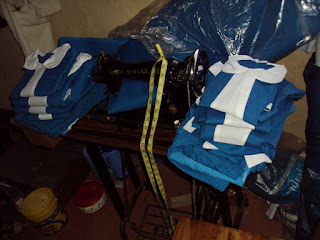 More beds have been purchased. Most children have had to double up--not bad for the smaller children but the bigger ones really need to have their own beds. More still are needed.
More beds have been purchased. Most children have had to double up--not bad for the smaller children but the bigger ones really need to have their own beds. More still are needed.
Martin was able to purchase another acre of land. In the photo on the right children are enjoying fruit from a tree on the new land. Another acre to grow crops means being closer to the goal of self-sufficiency.
 Martin has finished the insides of the classrooms as funds have been available. There is just one classroom yet to be finished.
Martin has finished the insides of the classrooms as funds have been available. There is just one classroom yet to be finished.
Many people who went on the March trip donated money for about 100 new uniforms as a memorial to Mary Young. Hellen, the seamstress, really has her work cut out for her!



